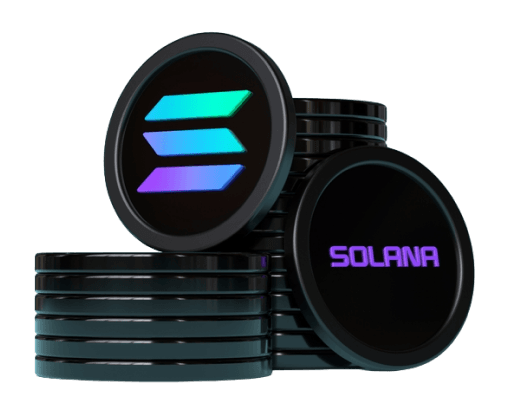Solana (SOL):
Revolutionizing Blockchain Technology


Solana (SOL) is a high-performance blockchain platform engineered for speed and scalability, aiming to overcome the limitations of earlier networks like Ethereum. This overview examines the Solana network's core technologies, its advantages, and the hurdles it currently faces.
What is Solana: General Overview
Solana is an open-source blockchain protocol designed for high-speed transaction processing. Its primary innovation is a consensus mechanism called Proof of History (PoH), which chronologically orders transactions to enhance processing speed. By assigning cryptographic timestamps to each block, Solana can theoretically process up to 50,000 transactions per second (TPS) with confirmation times under a second. This throughput significantly surpasses that of Bitcoin and Ethereum's base layer, making Solana a compelling platform for decentralized applications.
Solana's Core Infrastructure
Solana's infrastructure is built around its unique Proof of History (PoH) consensus mechanism, distinguishing it from traditional Proof of Work (PoW) and Proof of Stake (PoS) systems. PoH creates a verifiable, chronological record of events on the blockchain. This feature allows network nodes to agree on the time and order of transactions without extensive communication, which drastically reduces latency and increases overall efficiency.
The Solana Ecosystem: dApps and Development
Solana's high scalability and low transaction fees have made it a prominent platform for decentralized applications (dApps). The network supports a diverse ecosystem of projects in Decentralized Finance (DeFi), Non-Fungible Tokens (NFTs), and Web3. Development on Solana primarily uses the Rust programming language, which is recognized for its performance and security, attracting a dedicated community of developers.
Solana Market Capitalization
A cryptocurrency's market capitalization is calculated by multiplying its current token price by the number of coins in circulation. Solana's market cap expanded rapidly following its launch, establishing it as a top-tier cryptocurrency, especially during the 2021 bull market. Its valuation is subject to volatility and is influenced by factors such as network performance, broader market trends, regulatory developments, and competition from other blockchain projects.
SOL Price History and Market Factors
Solana's price history is characterized by significant volatility, including rapid price increases and sharp corrections, with its all-time high reached in November 2021. The token's value is influenced by several factors, including technological advancements, the rate of dApp adoption on its platform, overall cryptocurrency market conditions, and potential regulatory shifts.
Creation History
The project that evolved into Solana was founded by Anatoly Yakovenko in 2017. Initially called Loom, it was rebranded to prevent confusion with another project. Solana Labs was formed in March 2018, and the mainnet beta went live in March 2020. The platform experienced remarkable growth, quickly increasing its market capitalization and number of network validators.
Key Differentiating Features
Solana distinguishes itself from other major blockchains with a unique suite of technologies designed to solve the scalability trilemma without sharding. Its key features include:
- Proof of History (PoH): A consensus mechanism that creates a verifiable passage of time for transactions.
- High Throughput: The ability to process tens of thousands of transactions per second with sub-second finality.
- Tower BFT: An optimized version of Practical Byzantine Fault Tolerance used for reaching consensus.
- Gulf Stream: A protocol for forwarding transactions to validators before the current block is finalized, reducing latency.
- Sealevel: A parallel smart contract run-time that optimizes resource usage across the network.
- Rust Programming Language: Enables the development of secure and high-performance applications.
Securing the Network: Staking Instead of Mining
Solana secures its network using a Proof of Stake (PoS) consensus mechanism, which operates alongside Proof of History (PoH). This system eliminates the need for energy-intensive mining. Instead, participants known as validators process transactions and create new blocks. To become a validator, an individual or entity must lock up a substantial amount of SOL tokens, a process called staking. Token holders who do not run their own validator node can delegate their SOL to a validator of their choice. Both validators and delegators earn rewards from transaction fees and network inflation for their role in securing the network.
Challenges and Criticisms
Despite its high performance, Solana has faced notable challenges. The network experienced several significant outages, particularly in 2022, which temporarily halted block production and raised concerns about its stability under heavy load. Critics also highlight risks related to centralization; the demanding hardware requirements for running a validator node have resulted in a smaller validator count compared to networks like Ethereum. Furthermore, the rapid growth of its blockchain data poses an ongoing challenge for storage and long-term network scalability.
Where to Buy SOL Tokens
SOL tokens can be acquired on numerous platforms. The most common venues include major centralized exchanges (CEXs) like Binance, Coinbase, and Kraken, which offer high liquidity and various trading pairs. Additionally, decentralized exchanges (DEXs) built on Solana, such as Jupiter and Raydium, facilitate peer-to-peer token swaps using smart contracts. When selecting a platform, it is important to evaluate factors like security, transaction fees, and user experience.
Conclusion
Solana has secured its position as a leading blockchain platform, primarily due to its exceptional transaction speed and low costs. These features make it an attractive environment for developers and users of next-generation decentralized applications. However, the project continues to work through challenges related to network reliability and decentralization as it evolves.
Frequently asked questions
-
What is Solana (SOL)?
Solana is a high-performance blockchain designed for fast, scalable, and user-friendly decentralized applications (dApps). Its native cryptocurrency is SOL. -
How does Solana achieve its high transaction speeds?
Solana uses a unique consensus mechanism called Proof of History (PoH), which creates a verifiable timestamped order of transactions. This innovation works with Proof of Stake (PoS) to reduce latency and allow the network to process thousands of transactions per second. -
What is the difference between Solana and Ethereum?
The primary difference lies in their architecture. Solana is built as a single, high-throughput layer-1 blockchain, prioritizing speed and low fees. Ethereum focuses on a modular design, using layer-2 solutions for scalability, and is generally considered more decentralized. -
Is Solana mined like Bitcoin?
No, Solana does not use mining. It is secured through Proof of Stake (PoS), where participants called validators lock up SOL tokens (a process known as staking) to validate transactions and create new blocks in exchange for rewards. -
What are the main risks associated with Solana?
Solana has faced challenges with network reliability, including several outages that temporarily halted the blockchain. It also faces criticism regarding decentralization, as the high hardware costs to run a validator node limit the number of participants compared to other networks.
Our website uses cookies. Our Cookie Policy
